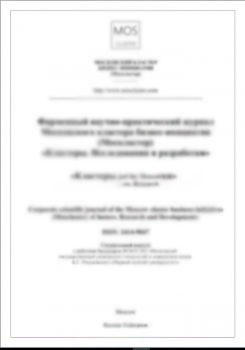Bryansk, Bryansk, Russian Federation
Russian Federation
The article discusses the possibility of using the object model for constructive solutions of devices to increase the tractive qualities of locomotives. The proposed approach has been tested on the example of creating a device to improve the traction qualities of a locomotive by applying a magnetic field to the wheel-rail contact zone. The use of the proposed device will reduce losses associated with eddy currents induced by a magnetic field in the wheels and rail, as well as reduce the probability
contact mechanics of engineering surfaces, friction and wear of interfaces, tribotechnical materials science, mechanics and control processes, kinematics, dynamics, strength and reliability of machines and structural elements
1. F. P. Brooks, “The design of design,” (Upper Saddle River NJ: Addison-Wesley, 2010).
2. V. Cacchiani, “Models and Algorithms for Combinatorial Optimization Problems arising in Railway Applications,” Dottorato di Ricerca in Automatica e Ricerca Operativa, UNIVERSITA DEGLI STUDI DI BOLOGNA, 2009.
3. G. Pahl, W. Beitz, J. Feldhusen, and K.H. Grote, “Engineering Design - A Systematic Approach,” (Berlin: Springer-Verlag, 2007).
4. L. Ma, X.-X. Zhang, J. Guo and X.-M. Wang, “Optimization model and algorithm for rolling stock maintenance scheduling in metro,” WIT Transactions on The Built Environment 162, 355-366 (2016).
5. D. Wagner “Algorithms and Models for Railway Optimization,” (WADS LNCS 2748, Springer-Verlag, Berlin, Heidelberg, 2003), pp. 198-206.
6. K. Best, “Design management. Managing design strategy, process and implementation,” Lausanne: AVA Academia, 2006.
7. N. Sasikalaa, P.V. Kishore “Train bogie part recognition with multi-object multi-template matching adaptive algorithm,” Journal of King Saud University - Computer and Information Sciences 32, 608-617 (2020).
8. D. Maffin, “Engineering Design Models: context, theory and practice,” Journal of Engineering Design 9(4), 315-327 (1998).
9. R. Agrawal and H. Jagadish, “Algorithms for Searching Massive Graphs,” IEEE Transact. Knowledge and Data Eng. 6, 225-238 (1994).
10. L. Finkelstein and A. Finkelstein, “Review of Design Methododlogy,” Design & systems, 95-121 (1995).
11. R.V Nandish and S. Yaseen, “Design and Analysis of Bogie Truck,” (Bommanahalli, Bangalore, 2014) pp. 1-19.
12. Suslov A.G., Fedonin O.N., Gorlenko A.O., Shalygin M.G., Zaharov L.A. Innovacionnye tehnologii mashinostroeniya, obespechivayuschie povyshenie dolgovechnosti zheleznodorozhnyh koles i rel'sov // Naukoemkie tehnologii v mashinostroenii. 2019. № 7(97). S. 3-8. DOI: https://doi.org/10.30987/article_5cf7bd2f83f6b5.55900953
13. Shalygin M.G. Parametry subsherohovatosti poverhnosti pri razlichnyh tehnologiyah obrabotki i ih vliyanie na iznos // Trenie i iznos. 2019. T. 40. № 3. S. 272-277.
14. Fedonin O.N., Shalygin M.G. Povyshenie korrozionnoy stoykosti i iznosostoykosti izdeliy transportnogo i himicheskogo mashinostroeniya // Naukoemkie tehnologii v mashinostroenii. 2020. № 8. S. 3-10.
15. D.Y. Antipin, V.I. Vorobiev and M.A. Maslov, “Improving the construction of magnetic clutch amplifiers of locomotive wheels with rails,” Lecture Notes in Mechanical Engineering 9783319956299, 2331-2338 (2019).
16. D.Y. Antipin, O.V. Izmerov, S.G. Shorokhov and D.G. Nadtochey, “Evaluation of indeterminacy of initial data for cad system of electric engine suspension,” IOP Conference Series: Materials Science and Engineering, 022006 (2018).
17. G. Petrov and A. Tarmaev, “Mathematical Model of Wheel Pairs Movement of a Rail Vehicles,” International Multi-Conference on Industrial Engineering and Modern Technologies (FarEastCon), 1-5. (2018).
18. G. Petrov and A. Tarmaev, “Modeling of railway vehicles movement having deviations in the content of running parts,” Proceedings of the International Conference: Aviamechanical Engineering and Transport (AVENT 2018). Series: Advances in Engineering Research, 158, 410-415 (2018).
19. G.I. Petrov and A.A. Tarmaev, “Improving of the Dynamic Qualities of Cars by Installing Wear-Resistant Vibration-Absorbing Elements in a Truck,” (Proceedings of the 6th International Symposium on Innovation and Sustainability of Modern Railway ISMR. Beijing, China Railway Publishing House, 2018), pp. 426-431.
20. Railway technical handbook, SKF Group (2012).
21. M. Gorbunov, V. Pistek, M. Kovtanets, J. Nozhenko, S. Kara and P. Kučera, “Research to improve traction and dynamic quality of locomotives,” JVE International LTD. Vibroengineering Procedia 13, 159-164 (2017).
22. J. Gerlici, K. Kravchenko, M. Gorbunov and T. Lack, “Increasing the Traction Properties of Locomotives for the Account of Improvement of Body and Bogies Connexions,” International Journal of Engineering & Technology 7, 377-382 (2018).
23. D.Y. Antipin and V.I. Vorobiev, “Design and dynamic problems of traction drive of electric locomotive 2es10 and proposals on its modernization,” IOP Conference Series: Earth and Environmental Science, 032001 (2018).
24. A.G. Suslov and M.G. Shalygin, “A wear model for subrough surface contacts of martensitic steels,” Proceedings of the Institution of Mechanical Engineers, Part J: Journal of Engineering Tribology (2019).
25. M.G. Shalygin, Surface Parameters with Different Treatment Technologies and Their Effect on Wear. J. Frict. Wear, 40 (2019).
26. M.G. Shalygin and S.V. Kuznetsov, “Technology to Increase Hydrocarbon Wear Resistance of Friction Units of Hydrogen Aggregates,” MATEC Web Conf. 297, 09001 (2019)






